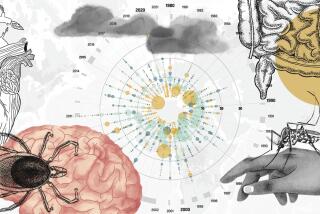Fragile Planet
- Share via
Two decades ago humanity was amazed and awed by a sight that it had never seen before: the Earth from space. The remarkable photos that were taken by American astronauts showed a sparkling, vibrant planet dominated by azure oceans and the swirling white clouds of the atmosphere. The image quickly gave rise to the sobriquet Spaceship Earth, becoming a central theme of the growing environmental movement.
Today the Earth might look just as vibrant and healthy from the same vantage point in space. But the experts know better. For all the environmental work that has been done in the past two decades, the Earth is not a very healthy place. The superficial symptoms of illness are everywhere, but often are shrugged off much as an individual might do with a nagging cough or little persistent pains.
The signs are impossible to ignore this year, however: record-high temperatures and severe drought, unprecedented ozone levels in the air of scores of American cities, seals dying in the North Sea, contaminated sea life in oceans throughout the world and refuse of all sorts washing up on beaches. Toxics continue to run off into rivers and estuaries and seep from disposal sites. Deadly used nuclear fuel is everywhere, waiting for a depository that presumably is safe for all time.
Scientists have provided substantial proof for years of the origins of acid rain, but still there is no effective program to combat this silent killer of lakes, streams and forests. Skin-cancer rates continue to rise, but only in the past year have threats to the ozone layer been considered with the gravity that they deserve. This year’s drought finally has convinced many that talk of a green-house effect caused by pollution is something to take seriously.
The cures of Earth’s ailments may not yet be evident, but the symptoms suddenly are not so mysterious, not so easy to disregard. Still, some people refuse to become alarmed because the pollution and contamination of the Earth do not directly affect them--they think. Others say that more study is needed. They are correct, but there are obvious turning points when enough study is enough and action is required. Others recognize the problems, at least superficially, but insist that the economic cost of cleaning up the Earth’s contamination is too high. They demand that there be trade-offs.
But one part of the problem is quite evident, and simple to fix: The United States does not do an adequate job of collecting and disseminating data about the environment. Information from the Environmental Protection Agency provides only a slice of the picture. The President’s Council of Environmental Quality has been virtually dormant since the Reagan Administration took office and did away with its widely distributed annual report. Other data is gathered and filed throughout the executive branch, but is never brought together in a central repository for analysis the way economic data is collected and studied.
The next Administration could provide a major service by adopting the recommendation of Paul R. Portney of Resources for the Future for the establishment of a Bureau of Environmental Statistics. Some will oppose the idea simply because all this information may lead Americans to recognize that the nation’s accumulated environmental problems are much more serious than they thought. The people may become convinced that the nation needs more environmental protection and conservation efforts, not less. The nation and the world cannot adopt appropriate cures until they have a proper diagnosis.
Some still will insist that the price is too high. But the cost of failure is unthinkable.






